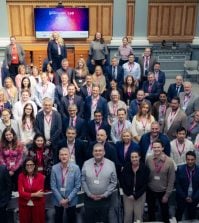Driving digital: the challenge of building tech skills – and the solutions

Competing with businesses to recruit in tech jobs markets, many governments struggle to develop the capabilities for digital delivery. At the Government Digital Summit, senior leaders from 16 countries swapped notes on how they’re creating the workforces required to transform services. Matt Ross reports
“One engineer, Marina, saved the government US$14m and two and a half years of pain and suffering,” said Edward Hartwig.
Marina’s department, the Deputy Administrator of the US Digital Service (USDS) explained, was about to sign a pricey contract with an IT contractor, “and she said: ‘Wait! Give me two days.’ She wrote a programme over a weekend, and in four weeks they solved the problem.”
Her contribution, said Hartwig, helps explain “why we hire people who are absolutely exceptional at what they do: because then we can give them something impossible to solve, and let them get on with it.”
In the discussion on capabilities at Global Government Forum’s inaugural Digital Summit – hosted during the autumn by the UK’s Government Digital Service (GDS) – Hartwig was setting out the USDS’s uncompromising approach to recruitment. “I have a talent team that is ten percent of my organisation,” he said. “They do targeted recruitment, and for every 209 [applicants] we hire one person. We do three interviews, and spend an average of 40 hours recruiting every single person.”
Putting this amount of effort into recruitment, Hartwig explained, enables him to bring in the rare skills he needs. Many of the US’s federal IT systems, he explained, are vast, complex and elderly – “and we’re working on systems that cannot fail. The US Medicare system [for older and disabled people] pays out US$2bn a day, and 57 million people rely on it for healthcare.” So USDS staff sent into departments to troubleshoot service outages must be able to tackle “unique and bespoke and incredibly difficult problems”, often working in programming languages “that haven’t been taught in their lifetimes.”

The Americans’ approach produces a very high-powered team, but a small one: the USDS employs about 170 people. And for many of Hartwig’s audience – 27 national and departmental digital leaders from 16 countries, who’d gathered in London for a day of informal debate and discussion – salary limits, small labour markets and urgent delivery needs demand a different approach to recruitment. “Whilst we’re competitive in terms of salaries, benefits and career opportunities for people in the early stages of their career, the top end of the management hierarchy is more challenging,” pointed out Colin Cook, the Scottish Government’s Director of Digital. So the discussion soon focused on one key question: given these constraints, how can government bodies attract and retain the digital skills they need?
Talent attracts talent
Talent attracts talent, commented Chan Cheow Hoe, the Government Chief Digital Technology Officer of Singapore: concentrate on recruiting inspirational, highly regarded leaders, he said, and they attract bright and ambitious people. “They represent a role model that builds the rest of the squad,” he said. “You can’t get good people unless you have good people at the top; and when you do, they kind of propagate downwards.”
Government’s “unique selling point” can also help attract talented staff, commented Tobias Plate, Head of the Digital State unit in Germany’s Federal Chancellery: it’s important to get the message out that “in public administration, you can make people’s lives better.” And Adrian Cooper, Field CTO for knowledge partner NetApp’s UK Public Sector operation, argued that employers can cast their nets more widely by recruiting for characteristics rather than qualifications. “The real visionaries are the people who have curiosity, that spark of imagination; if you’ve got curiosity, you’ll learn the tools,” he said. “But how do you describe curiosity in a job description? It challenges the way we recruit.”

So digital leaders should play a key role in recruiting, Cooper argued, rather than passing the task to HR teams: “You’ll only get good people if your senior managers go out there and hire people themselves.”
Re-engineering recruitment
Where possible, Hartwig argued, digital units should build recruitment processes around “a fluid set of competences” rather than a tight person specification. “We’ve stripped out the requirements that most people would look for. My director of engineering doesn’t have a college degree,” he commented.
Such flexibility in recruitment can also help boost digital teams’ diversity, as people from some minority groups tend to have fewer formal qualifications and less experience of civil service recruitment processes. And Hartwig was clear that a more diverse team “makes for better products” – bringing in “different perspectives” and, often, a better understanding of service users’ needs. “We get a lot of white male engineers building something like Medicare – which doesn’t serve white male engineers,” he pointed out.
In boosting diversity, Hartwig added, civil service’s commitment to equal pay is a real advantage – helping to attract women, ethnic minorities and disabled people who often find themselves underpaid in the private tech sector. “In my organisation, we pay everyone equally,” he said. And Kevin Cunnington, a former UK GDS chief now working as the UK’s Digital Envoy, pointed out that equalising pay across the digital profession brings further advantages – preventing departments from poaching each others’ specialists. Until recently, he explained, it was common to see departments “outbidding each other for key staff”: by codifying digital jobs and creating a government-wide system of pay bands, the profession’s leaders have reduced staff turnover.
Professional development

The creation of a strong, centrally-led digital profession has also helped the UK to manage its digital professionals as a coherent group, pointed out Neal Craig, Public Sector Digital Lead for knowledge partners PA Consulting: “Understanding where your best people are, and how to deploy them to maximum effect across the broader landscape, is a key element of the solution.” And another key element, as Cunnington pointed out, is the introduction of dedicated training and professional development courses – enabling departments to build the skills they can’t afford to keep buying in.
The UK’s Digital Academy, Cunnington explained, has trained 10,000 civil servants in digital skills. Meanwhile, added GDS Chief Operating Officer Fiona Deans, the civil service has set up digital, data and technology strands in both its apprenticeship system, and the ‘Fast Track’ leadership development programme. And Alison Pritchard, GDS’s current Director General, pointed to a data science training scheme run by GDS in partnership with a university and private businesses: they’d planned to offer 50 places on the free, eight-week training course, she recalled, but “we had over 2000 applications from across Europe, so we increased it to 80. And at the end, all 80 got hired.”

Such partnerships with higher education bodies and digital businesses can also boost digital skills among other key groups, commented Cameron Brooks, General Manager of knowledge partner Amazon Web Services’ (AWS’s) Europe Public Sector arm. For example, he said, AWS is working with the University of Exeter to build digital content into its courses for senior public servants, and doing similar work with France’s Sciences Po – which trains the next generation of administrative leaders. Ensuring that newly-recruited civil service leaders are digital-savvy, he argued, ensures that in future these issues will be understood “at all points of government organisations.”
A permeable workforce
Exchanges and secondments with digital businesses present another way to build government capability, added another delegate. “We get great work out of somebody for a limited period of time,” they said, while “bringing senior folks with fresh eyes into our organisation helps junior members of our team see very clearly what ‘good’ looks like.”
This approach also provides flexibility for public bodies that may not need to build up a permanent team, commented Craig: “It can help to meet the transformation needs of small organisations,” he said. “Allowing people to move across organisations and projects more fluidly gives both the public and private sectors the benefit of development and capacity. And it accelerates the cultural shift that’s needed, both in the civil service and among private sector providers.”
Finally, creating centres of expertise within government can help develop specialist skills, commented Maria Nikkilä, Head of the Digital Unit in Finland. “We’re created a service design unit, and that’s working well,” she said. “The next challenge is to build the same kind of unit for working with AI issues… not just the technical part, but also the legislation and changing processes.”

“Scotland is following exactly the same path,” noted Cook. “Our CivTech operation specialises in innovative procurement and business incubation, and new centres of expertise are being introduced around Robotic Process Automation, commercial and contract management, and cloud services.”
Getting the best out of business
So there are many ways to build capability. But Rūta Šatrovaitė, Head of Digital Policy for Lithuania’s ICT Association INFOBALT – which provides support and advice to the government – warned that in some countries, the yawning gap between private and public salaries for digital professionals presents a huge obstacle to recruitment and retention. Outsourcing digital work to the private sector brings its own problems, she said, “but in the short term, I think it’s the best solution for countries facing this challenge.”
In response, another delegate argued that while they have no problem with outsourcing work, officials should manage key parts of the process themselves: “Too often in the past, we’ve lobbed money over the fence to the private sector without taking ownership of the problem or retaining control over delivery.” Instead, they said, public servants should carry out the early “discovery” stages of the work – applying their knowledge of users’ needs and delivery environments to frame the problem and devise testable solutions – before commissioning contractors to do the heavy lifting on programming.

Central digital units can help departments with both tasks, when they’ve reached sufficient scale and maturity – and Hartwig, who gave a presentation on the USDS’s evolution, explained how he’s trying to build capability across government. Created to rescue the dysfunctional Obamacare user interface in 2014, USDS has since concentrated on putting out fires in the USA’s ageing IT infrastructure; but Hartwig and his boss Matt Cutts have been leading a shift towards preventive and capacity-building work. “From being called in for incident response,” he said, USDS is “trying to evolve into a mature organisation that can prevent harm instead of swooping in at the last minute”.
Leverage from the centre
USDS has no formal policy responsibilities, he explained: technology policy sits with the Office of the Federal CIO. But by working with other federal units to pilot and implement better systems and processes, it’s working to demonstrate the value of digital reforms – and win support for wider changes.
For example, the team has rebuilt the federal procurement system for digital projects, “rearranging it so that you can buy technology in a way that technologists would understand.” So rather than going to tender with a detailed final specification or paying for time and materials, officials can purchase development work to defined standards – then pursue the best solutions.
Small businesses often excel at this kind of work, but USDS found that many were deterred by onerous, complex federal procurement systems. Working with the Small Business Administration, Hartwig’s team built tools to ease the process of registering as a supplier and pitching for work, “unified under a single sign-in service, so they could have a seamless experience.” Many still lacked the scale or breadth to handle government contracts, but “our amazing vendor community banded together to build a community that helps one another,” he explained – teaming up on specific tenders. “This is an organic process that’s led to an exceptional amount of development when it comes to small, agile procurement shops,” he said.
When such changes produce good results, the policy owners get interested. And now, Hartwig explained, the Office of Management and Budget has decreed that “by 2022, every [federal] contracting officer in the United States buying technology worth more than US$7m” must have undertaken USDS training in digital procurement. Meanwhile another USDS system change initiative, covering the federal recruitment process, has resulted in a policy shift on interviewing and selection techniques: “We’ll spend the next year going to agency to agency, implementing this process,” he said.
During 90 minutes of free-flowing conversation, the group of digital leaders had covered many of the elements of building civil service capability. Reformed approaches to recruitment, diversity, marketing and leadership can bring in the right people. The centre has a crucial role to play, both in developing the cross-government function and in offering hands-on assistance. Staff training and development is required to build in-house skills, and intelligent commissioning is essential to buying in skills and capacity. But every country has a different starting point, and digital leaders have limited powers: in many cases – as in the USA – their best approach may be to demonstrate the power of digital, attracting the attention of business owners and policy makers who recognise that the old ways of doing things are not working.
“I would love to be the [UK’s] Government Digital Service, with the authority and the policy and the breadth of ability,” concluded Hartwig. “But I’m not. So we go into an agency, and work hand-in-hand with the people there. And we try very, very hard to get them to take ownership and pride in the thing they have accomplished.”
This is the second part of our series of reports on Global Government Forum’s Digital Summit, held in London late last year. The first part covers delegates’ discussions on how to create central digital units; the third examines the session on the use of data and identity verification; the fourth explores the issues around adopting new technologies such as artificial intelligence; and the fifth and final chapter considers a new and more supportive role for central digital teams.
The Summit was an ‘off the record’ event, but we have secured delegates’ consent to publishing these quotes – allowing us to report on the discussions while protecting delegates’ ability to speak freely.
Global Government Digital Summit 2019 attendees
In alphabetical order by surname
Civil servants:
- Caron Alexander, Director of Digital Services, Northern Ireland Civil Service, Northern Ireland
- Chan Cheow Hoe, Government Chief Digital Technology Officer, Smart Nation and Digital Government Office, & Deputy Chief Executive, Government Technology Agency of Singapore, Singapore
- Kevin Cunnington, Director General of International Government Service, United Kingdom
- Colin Cook, Director of Digital, The Scottish Government, Scotland
- Fiona Deans, Chief Operating Officer, Government Digital Service, United Kingdom
- Anna Eriksson, Director General, DIGG, Sweden
- Edward Hartwig, Deputy Administrator, U.S. Digital Service, The White House, USA
- Paul James, Chief Executive, Department of Internal Affairs, and Government Chief Digital Officer, New Zealand
- Lauri Lugna, Permanent Secretary, Ministry of the Interior, Estonian
- Richard Matthews, Director of CTS and Lead for the Technology Transition Programme, Digital & Technology, Ministry of Justice, United Kingdom
- Jessica McEvoy, Deputy Director for UK & International at Government Digital Service, United Kingdom
- Simon McKinnon, Chief Digital and Information Officer, Department for Work and Pensions (DWP), United Kingdom
- Helen Mott, Head of Digital, Justice Digital and Technology, Ministry of Justice, United Kingdom
- Maria Nikkilä, Head of Digital Unit, Public Sector ICT Department, Finland
- Iain O’Neil, Director, Digital Strategy, NHSX, United Kingdom
- Tobias Plate, Head of Unit Digital State, Federal Chancellery, Germany
- Ian Porée, Executive Director, Community Interventions, Her Majesty’s Prison and Probation Service, Ministry of Justice, United Kingdom
- Alison Pritchard, Director General of the Government Digital Service, United Kingdom (Host)
- Mikhail Pryadilnikov, Head, Center of Competence for Digital Government Transformation, Russia
- Line Richardsen, Head of Analysis, Department of ICT Policy and Public Sector Reform, Ministry of Local Government and Modernisation, Norway
- Francisco Rodriguez, Head of Digital Government Division, Ministry of the Presidency, Chile
- Carlos Santiso, Director, Governance Practice, Digital Innovation in Government, Development Bank of Latin America, Colombia
- Aaron Snow, Chief Executive Officer, Canadian Digital Service, Canada
- Huw Stephens, Chief Information Officer – Information Workplace Solutions and Treasury Group Shared Services, HM Treasury, United Kingdom
- Diane Taylor-Cummings, Diane Taylor-Cummings, Deputy Director Project Delivery Profession, IPA, United Kingdom
- Rūta Šatrovaitė, Head of Digital Policy, ICT Association INFOBALT, Lithuania (former civil servant)
Knowledge Partners:
- Neal Craig, Public Sector Digital Lead, PA Consulting
- Per Blom, Government and Public Sector Lead, PA Consulting
- Natalie Taylor, Digital Transformation Expert, PA Consulting
- Cameron J. Brooks, General Manager, Europe Public Sector, Amazon Web Services
- Chris Hayman, Director of Public Sector, UK and Ireland, Amazon Web Services
- Greg Ainslie-Malik, Machine Learning Architect, Splunk
- Ben Emslie, Head of Public Sector UK and Ireland, Splunk
- Gordon Morrison, Director for EMEA Government Affairs, Splunk
- Adrian Cooper, Field CTO UK Public Sector, NetApp
- Alwin Magimay, Chief Transformation Officer, PMI
Global Government Forum:
- Matt Ross, Editorial Director
- Kevin Sorkin, Chief Executive























